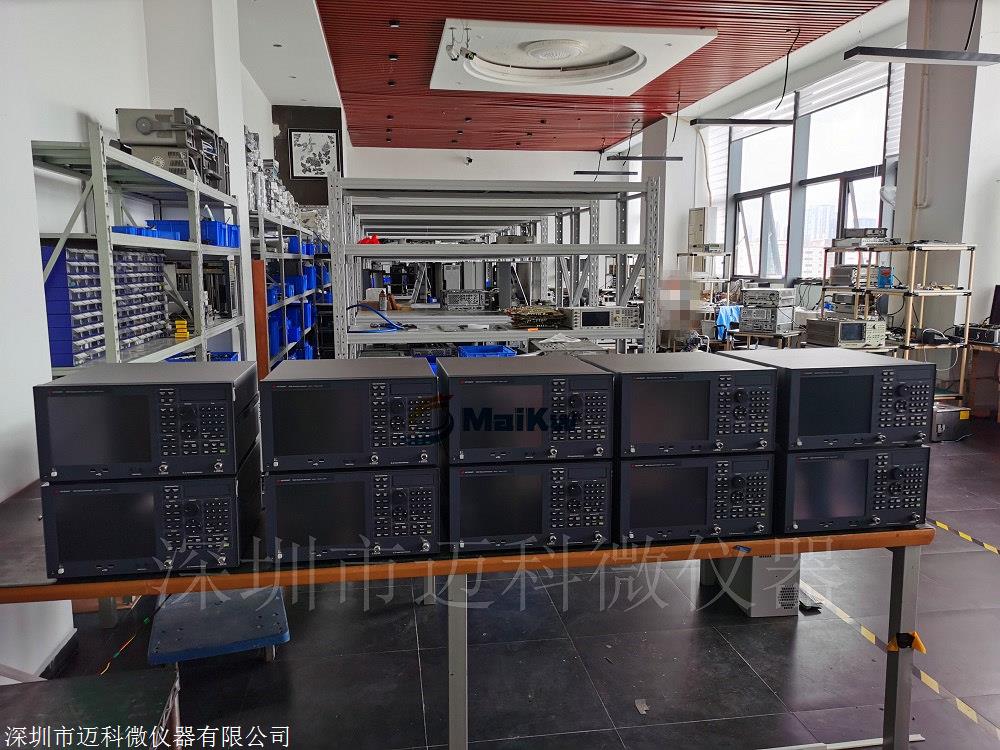迈科微仪器维修中心,专注于维修安捷伦近二十年,拥有对安捷伦N90XX系列N9010A信号分析仪丰富的维修经验和安捷伦仪器维修的知识,能够达到送修一小时检测和拆机讲解,真正让顾客更了解故障、更清楚问题的所在、更安心的交给我们团队维修
迈科微仪器维修中心主要维修进口仪器,强项是高频的射频微波仪器维修常修的品牌包括:Keysight是德科技(以及原来的安捷伦)、罗德与施瓦茨这两个品牌比较多,其他就是安利、泰克等等主要的类型有:网络分析仪、频谱分析仪、信号发生器、示波器、信号分析仪、综合测试仪、接收机等等
本团队接修的仪器属完全自主维修,很多同行难修的仪器也转到我们这修,同时欢迎更多同行将难修的进口高频仪器转到我们公司维修我司维修的仪器技术指标均可通过计量,并且提供保修服务
另外本公司提供54台安捷伦网络分析仪E5071C 可供各企业租赁使用,详情可详谈
其他业务包括:仪器回收、二手仪器出售

 频率 10 Hz 至 44 GHz
频率 10 Hz 至 44 GHz
频率选件 3.6、7、13.6、26.5、32、44 GHz,使用混频器可达 1.1 THz标准衰减器衰减范围 60 dB标准衰减器步进 10 dB实时带宽选件 无1 GHz 时的 DANL -170 dBm至大分析带宽 40 MHz1 GHz 时,1 MHz 频偏处的相位噪声 -136 dBc/Hz1 GHz 时,10 kHz 频偏处的相位噪声 -109 dBc/Hz1 GHz 时,30 kHz 频偏处的相位噪声 -109 dBc/Hz无杂散动态范围 无三阶截获(TOI),1 GHz 时 +18 dBm可用应用 是至大实时带宽 无总体幅度精度 ±0.27 dB带宽选件 标配 25,40 MHz
a. The warranted performance is only the sum of all errors under autocoupled conditions. Under non-autocoupledconditions, the frequency readout accuracy will nominally meet the specification equation, except for conditionsin which the RBW term dominates, as explained in examples below. The nominal RBW contribution to frequencyreadout accuracy is 2% of RBW for RBWs from 1 Hz to 390 kHz, 4% of RBW from 430 kHz through 3 MHz (thewidest autocoupled RBW), and 30% of RBW for the (manually selected) 4, 5, 6 and 8 MHz RBWs.First example: a 120 MHz span, with autocoupled RBW. The autocoupled ratio of span to RBW is 106:1, so theRBW selected is 1.1 MHz. The 5% × RBW term contributes only 55 kHz to the total frequency readout accuracy,compared to 300 kHz for the 0.25% × span term, for a total of 355 kHz. In this example, if an instrument had anunusually high RBW centering error of 7% of RBW (77 kHz) and a span error of 0.20% of span (240 kHz), thetotal actual error (317 kHz) would still meet the computed specification (355 kHz).Second example: a 20 MHz span, with a 4 MHz RBW. The specification equation does not apply because theSpan: RBW ratio is not autocoupled. If the equation did apply, it would allow 50 kHz of error (0.25%) due to thespan and 200 kHz error (5%) due to the RBW. For this non-autocoupled RBW, the RBW error is nominally 30%,or 1200 kHz.b. Horizontal resolution is due to the marker reading out one of the sweep points. The points are spaced byspan/(Npts –1), where Npts is the number of sweep points. For example, with the factory preset value of 1001sweep points, the horizontal resolution is span/1000. However, there is an exception: When both the detectormode is “normal” and the span > 0.25 × (Npts –1) × RBW, peaks can occur only in even-numbered points, sothe effective horizontal resolution becomes doubled, or span/500 for the factory preset case. When the RBW isautocoupled and there are 1001 sweep points, that exception occurs only for spans > 750 MHz.c. Specifications apply to traces in most cases, but there are exceptions. Specifications always apply to the peakdetector. Specifications apply when only one detector is in use and all active traces are set to Clear Write. Specificationsalso apply when only one detector is in use in all active traces and the "Restart" key has been pressedsince any change from the use of multiple detectors to a single detector. In other cases, such as when multiplesimultaneous detectors are in use, additional errors of 0.5, 1.0 or 1.5 sweep points will occur in some detectors,depending on the combination of detectors in use.d. In most cases, the frequency readout accuracy of the analyzer can be exceptionally good. As an example, Keysighthas characterized the accuracy of a span commonly used for Electro-Magnetic Compatibility (EMC) testingusing a source frequency locked to the analyzer. Ideally, this sweep would include EMC bands C and D and thussweep from 30 to 1000 MHz. Ideally, the analysis ban**idth would be 120 kHz at −6 dB, and the spacing of thepoints would be half of this (60 kHz). With a start frequency of 30 MHz and a stop frequency of 1000.2 MHz anda total of 16168 points, the spacing of points is ideal. The detector used was the Peak detector. The accuracy offrequency readout of all the points tested in this span was with ±0.0032% of the span. A perfect analyzer withthis many points would have an accuracy of ±0.0031% of span. Thus, even with this large number of displaypoints, the errors in excess of the bucket quantization limitation were negligible.





 企业特殊行业经营资质信息公示
企业特殊行业经营资质信息公示


